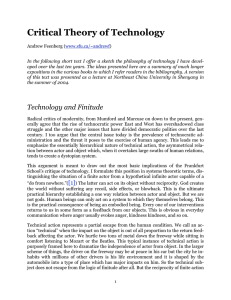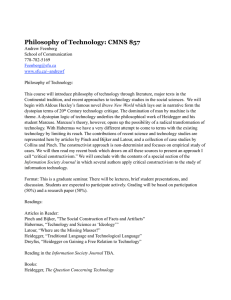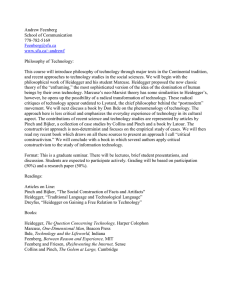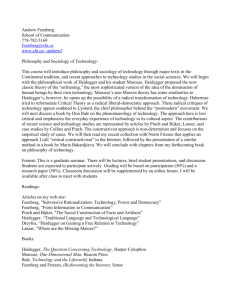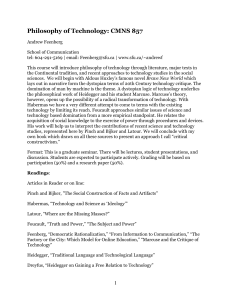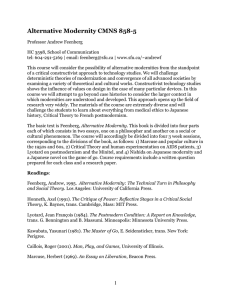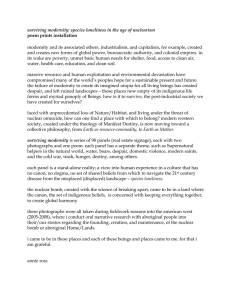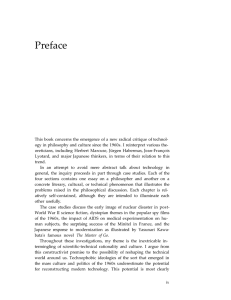Critical Theory of Technology: An Overview Andrew Feenberg
advertisement
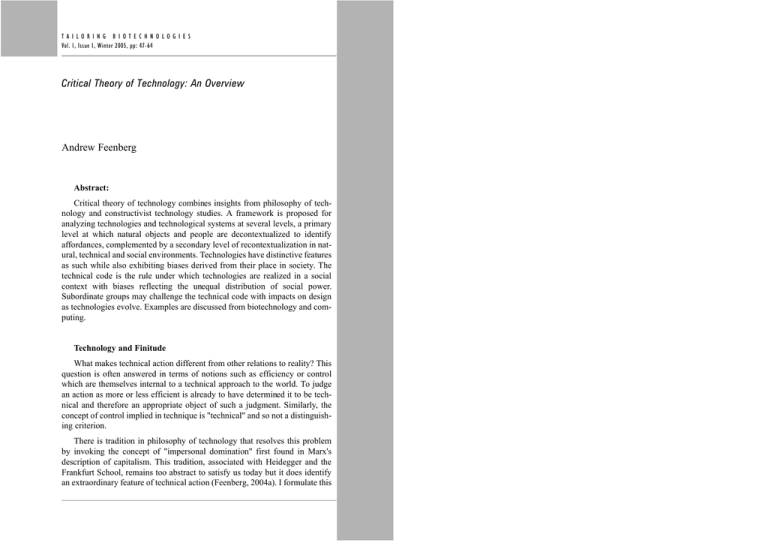
TA I LO R I N G B I O T E C H N O LO G I E S Vol. 1, Issue 1, Winter 2005, pp: 47-64 Critical Theory of Technology: An Overview Andrew Feenberg Abstract: Critical theory of technology combines insights from philosophy of technology and constructivist technology studies. A framework is proposed for analyzing technologies and technological systems at several levels, a primary level at which natural objects and people are decontextualized to identify affordances, complemented by a secondary level of recontextualization in natural, technical and social environments. Technologies have distinctive features as such while also exhibiting biases derived from their place in society. The technical code is the rule under which technologies are realized in a social context with biases reflecting the unequal distribution of social power. Subordinate groups may challenge the technical code with impacts on design as technologies evolve. Examples are discussed from biotechnology and computing. Technology and Finitude What makes technical action different from other relations to reality? This question is often answered in terms of notions such as efficiency or control which are themselves internal to a technical approach to the world. To judge an action as more or less efficient is already to have determined it to be technical and therefore an appropriate object of such a judgment. Similarly, the concept of control implied in technique is "technical" and so not a distinguishing criterion. There is tradition in philosophy of technology that resolves this problem by invoking the concept of "impersonal domination" first found in Marx's description of capitalism. This tradition, associated with Heidegger and the Frankfurt School, remains too abstract to satisfy us today but it does identify an extraordinary feature of technical action (Feenberg, 2004a). I formulate this TA I LO R I N G B I O T E C H N O LO G I E S feature in systems theoretic terms, distinguishing the situation of a finite actor from a hypothetical infinite actor capable of a "do from nowhere."1 The latter can act on its object without reciprocity. God creates the world without suffering any recoil, side effects, or blowback. This is the ultimate practical hierarchy establishing a one way relation between actor and object. But we are not gods. Human beings can only act on a system to which they themselves belong. This is the practical significance of embodiment. As a consequence, every one of our interventions returns to us in some form as feedback from our objects. This is obvious in everyday communication where anger usually evokes anger, kindness, and so on. Technical action represents a partial escape from the human condition. We call an action "technical" when the actor's impact on the object is out of all proportion to the return feedback affecting the actor. We hurtle two tons of metal down the freeway while sitting in comfort listening to Mozart or the Beatles. This typical instance of technical action is purposely framed here to dramatize the independence of actor from object. In the larger scheme of things, the driver on the freeway may be at peace in his car but the city he inhabits with millions of other drivers is his life environment and it is shaped by the automobile into a type of place that has major impacts on him. So the technical subject does not escape from the logic of finitude after all. But the reciprocity of finite action is dissipated or deferred in such a way as to create the space of a necessary illusion of transcendence. Heidegger and Marcuse understand this illusion as the structure of modern experience. According to Heidegger's history of being, the modern "revealing" is biased by a tendency to take every object as a potential raw material for technical action. Objects enter our experience only in so far as we notice their usefulness in the technological system. Release from this form of experience may come from a new mode of revealing but Heidegger has no idea how revealings come and go. Like Marcuse, I relate the technological revealing not to the history of being, but to the consequences of persisting divisions between classes and between rulers and ruled in technically mediated institutions of all types. Technology can be and is configured in such a way as to reproduce the rule of the few over the many. This is a possibility inscribed in the very structure of technical action which establishes a one way direction of cause and effect. 48 1 The implied reference is to the concept of a godlike "view from nowhere." If it were not too cute, one might rephrase the point here as a "do from knowhere," i.e. action understood as just as indifferent to its objects as detached knowing. CRITICAL THEORY OF TECHNOLOGY: AN OVERVIEW Technology is a two-sided phenomenon: on the one hand the operator, on the other the object. Where both operator and object are human beings, technical action is an exercise of power. Where, further, society is organized around technology, technological power is the principle form of power in the society. It is realized through designs which narrow the range of interests and concerns that can be represented by the normal functioning of the technology and the institutions which depend on it. This narrowing distorts the structure of experience and causes human suffering and damage to the natural environment. The exercise of technical power evokes resistances of a new type immanent to the one-dimensional technical system. Those excluded from the design process eventually suffer the undesirable consequences of technologies and protest. Opening up technology to a wider range of interests and concerns could lead to its redesign for greater compatibility with the human and natural limits on technical action. A democratic transformation from below can shorten the feedback loops from damaged human lives and nature and guide a radical reform of the technical sphere. Instrumentalization Theory Much philosophy of technology offers very abstract and unhistorical accounts of the essence of technology. These accounts appear painfully thin compared to the rich complexity revealed in social studies of technology. Yet technology has the distinguishing features sketched above and these have normative implications. As Marcuse argued in One-Dimensional Man, the choice of a technical rather than a political or moral solution to a social problem is politically and morally significant. The dilemma divides technology studies into two opposed branches. Most essentialist philosophy of technology is critical of modernity, even anti-modern, while most empirical research on technologies ignores the larger issue of modernity and thus appears uncritical, even conformist, to social critics (Feenberg 2003). I find it difficult to explain my solution to this dilemma as it crosses lines we are used to standing behind. These lines cleanly separate the substantivist critique of technology as we find it in Heidegger from the constructivism of many contemporary historians and sociologists. These two approaches are usually seen as totally opposed. Nevertheless, there is something obviously right in both. I have therefore attempted to combine their insights in a common 49 TA I LO R I N G B I O T E C H N O LO G I E S framework which I call "instrumentalization theory." Instrumentalization theory holds that technology must be analyzed at two levels, the level of our original functional relation to reality and the level of design and implementation. At the first level, we seek and find affordances that can be mobilized in devices and systems by decontextualizing the objects of experience and reducing them to their useful properties. This involves a process of de-worlding in which objects are torn out of their original contexts and exposed to analysis and manipulation while subjects are positioned for distanced control. Modern societies are unique in de-worlding human beings in order to subject them to technical action-we call it management-and in prolonging the basic gesture of de-worlding theoretically in technical disciplines which become the basis for complex technical networks. At the second level, we introduce designs that can be integrated with other already existing devices and systems and with various social constraints such as ethical and aesthetic principles. The primary level simplifies objects for incorporation into a device while the secondary level integrates the simplified objects to a natural and social environment. This involves a process which, following Heidegger, we can call "disclosure" or "revealing" of a world. Disclosing involves a complementary process of realization which qualifies the original functionalization by orienting it toward a new world involving those same objects and subjects. These two levels are analytically distinguished. No matter how abstract the affordances identified at the primary level, they carry social content from the secondary level in the elementary contingencies of a particular approach to the materials. Similarly, secondary instrumentalizations such as design specifications presuppose the identification of the affordances to be assembled and concretized. This is an important point. Cutting down a tree to make lumber and building a house with it are not the primary and secondary instrumentalizations respectively. Cutting down a tree "decontextualizes" it, but in line with various technical, legal and aesthetic considerations determining what kinds of trees can become lumber of what size and shape and are salable as such. The act of cutting down the tree is thus not simply "primary" but involves both levels as one would expect of an analytic distinction. 50 The theory is complicated, however, by the peculiar nature of differentiated modern societies. Some of the functions of the secondary instrumentalization do get distinguished institutionally rather than analytically. Thus the aesthetic function, an important secondary instrumentalization, may be separated out and assigned to a corporate "design division." Artists will then work in par- CRITICAL THEORY OF TECHNOLOGY: AN OVERVIEW allel with engineers. This partial institutional separation of the levels of instrumentalization encourages the belief that they are completely distinct. This obscures the social nature of every technical act, including the work of engineers liberated from aesthetic considerations, if not from many other social influences, by their corporate environment. Analysis at the first level is inspired by categories introduced by Heidegger and other substantivist critics of technology. However, because I do not ontologize those categories, nor treat them as a full account of the essence of technology, I believe I am able to avoid many of the problems associated with substantivism, particularly its anti-modernism. Analysis at the second level is inspired by empirical study of technology in the constructivist vein. I focus especially on the way actors perceive the meanings of the devices and systems they design and use. But again, I am selective in drawing on this tradition. I do not accept its exaggerated and largely rhetorical empiricism and its rejection of the categories of traditional social theory. Instead, I attempt to integrate its methodological insights to a more broadly conceived theory of modernity. Culture In determinist and instrumentalist accounts of technology, efficiency serves as the unique principle of selection between successful and failed technical initiatives. On these terms technology appears to borrow the virtues generally attributed to scientific rationality. Philosophy of technology demystifies these claims to the necessity and universality of technical decisions. In the 1980s, the constructivist turn in technology studies offered a methodologically fruitful approach to demonstrating this in a wide range of concrete cases. Constructivists show that many possible configurations of resources can yield a working device capable of efficiently fulfilling its function. The different interests of the various actors involved in design are reflected in subtle differences in function and preferences for one or another design of what is nominally the same device. Social choices intervene in the selection of the problem definition as well as its solution. Efficiency is thus not decisive in explaining the success or failure of alternative designs since several viable options usually compete at the inception of a line of development. Technology is "underdetermined" by the criterion of efficiency and responsive to the various particular interests and ideologies that select among these options. Technology is not "rational" in the old positivist sense of the term but socially relative; the outcome of technical choices is a world that supports the way of life of one or another 51 TA I LO R I N G B I O T E C H N O LO G I E S influential social group. On these terms the technocratic tendencies of modern societies could be interpreted as an effect of limiting the groups intervening in design to technical experts and the corporate and political elites they serve. In my formulation of this thesis, I argue that the intervention of interests and ideologies does not necessarily reduce efficiency, but biases its achievement according to a broader social program. I have introduced the concept of "technical code" to articulate this relationship between social and technical requirements. A technical code is the realization of an interest or ideology in a technically coherent solution to a problem. Although some technical codes are formulated explicitly by technologists themselves, I am seeking a more general analytic tool that can be applied even in the absence of such formulations. More precisely, then, a technical code is a criterion that selects between alternative feasible technical designs in terms of a social goal. "Feasible" here means technically workable. Goals are "coded" in the sense of ranking items as ethically permitted or forbidden, or aesthetically better or worse. or more or less socially desirable. These types of codes reflect the secondary instrumentalizations of the instrumentalization theory, such as ethical and aesthetic mediations. "Socially desirable" refers not to some universal criterion but to a hegemonic value such as health or the nuclear family. Such values are formulated by the social theorist as technical codes in ideal-typical terms, i.e. as a simple rule or criterion. A prime example in the history of technology is the imperative requirement to deskill labor in the course of industrialization rather than preserving or enhancing skills. Where such codes are reinforced by individuals' perceived self-interest and law, their political import usually passes unnoticed. This is what it means to call a certain way of life culturally secured and a corresponding power hegemonic. Just as political philosophy problematizes cultural formations that have rooted themselves in law, so philosophy of technology problematizes formations that have successfully rooted themselves in technical codes. Operational Autonomy For many of critics of technological society, Marx is now irrelevant, an outdated critic of capitalist economics. I disagree. I believe Marx had important insights for philosophy of technology. He focused so exclusively on economics because production was the principal domain of application of technology in his time. With the penetration of technical mediation into every sphere of social life, the contradictions and potentials he identified in technol52 CRITICAL THEORY OF TECHNOLOGY: AN OVERVIEW ogy follow as well. In Marx the capitalist is ultimately distinguished not so much by ownership of wealth as by control of the conditions of labor. The owner has not merely an economic interest in what goes on within his factory, but also a technical interest. By reorganizing the work process, he can increase production and profits. Control of the work process, in turn, leads to new ideas for machinery and the mechanization of industry follows in short order. This leads over time to the invention of a specific type of machinery which deskills workers and requires management. Management acts technically on persons, extending the hierarchy of technical subject and object into human relations in pursuit of efficiency. Eventually professional managers represent and in some sense replace owners in control of the new industrial organizations. Marx calls this the impersonal domination inherent in capitalism in contradistinction to the personal domination of earlier social formations. It is a domination embodied in the design of tools and the organization of production. In a final stage, which Marx did not anticipate, techniques of management and organization and types of technology first applied to the private sector are exported to the public sector where they influence fields such as government administration, medicine, and education. The whole life environment of society comes under the rule of technique. In this form the essence of the capitalist system can be transferred to socialist regimes built on the model of the Soviet Union.2 The entire development of modern societies is thus marked by the paradigm of unqualified control over the labor process on which capitalist industrialism rests. It is this control which orients technical development toward disempowering workers and the massification of the public. I call this control "operational autonomy," the freedom of the owner or his representative to make independent decisions about how to carry on the business of the organization, regardless of the views or interests of subordinate actors and the surrounding community. The operational autonomy of management and administration positions them in a technical relation to the world, safe from the consequences of their own actions. In addition, it enables them to reproduce the conditions of their own supremacy at each iteration of the technologies they command. Technocracy is an extension of such a system to society as a whole in response to the spread of technology and management to every sector of social life. Technocracy armors itself against public pressures, sacrifices val2 How Marx could overlook this possible outcome, along with most 19th Century radicals thinkers, is discussed in Feenberg (2004b) through a comparison of Edward Bellamy's utopian novel Looking Backward and Huxley's famous dystopia, Brave New World, which each exemplify a different conception of the boundaries of technique. 53 TA I LO R I N G B I O T E C H N O LO G I E S ues, and ignores needs incompatible with its own reproduction and the perpetuation of its technical traditions. The technocratic tendency of modern societies represents one possible path of development, a path that is peculiarly truncated by the demands of power. Technology has other beneficial potentials that are suppressed under the capitalism and state socialism that could emerge along a different developmental path. In subjecting human beings to technical control at the expense of traditional modes of life while sharply restricting participation in design, technocracy perpetuates elite power structures inherited from the past in technically rational forms. In the process it mutilates not just human beings and nature, but technology as well. A different power structure would innovate a different technology with different consequences. Is this just a long detour back to the notion of the neutrality of technology? I do not believe so. Neutrality generally refers to the indifference of a specific means to the range of possible ends it can serve. If we assume that technology as we know it today is indifferent with respect to human ends in general, then indeed we have neutralized it and placed it beyond possible controversy. Alternatively, it might be argued that technology as such is neutral with respect to all the ends that can be technically served. But neither of these positions make sense. There is no such thing as technology as such. Today we employ this specific technology with limitations that are due not only to the state of our knowledge but also to the power structures that bias this knowledge and its applications. This really existing contemporary technology favors specific ends and obstructs others. The larger implication of this approach has to do with the ethical limits of the technical codes elaborated under the rule of operational autonomy. The very same process in which capitalists and technocrats were freed to make technical decisions without regard for the needs of workers and communities generated a wealth of new "values," ethical demands forced to seek voice discursively. Most fundamentally, democratization of technology is about finding new ways of privileging these excluded values and realizing them in the new technical arrangements. 54 A fuller realization of technology is possible and necessary. We are more and more frequently alerted to this necessity by the threatening side effects of technological advance. Technology "bites back," as Edward Tenner reminds us, with fearful consequence as the deferred feedback loops that join technical subject and object become more obtrusive (Tenner 1996). The very success of our technology in modifying nature insures that these loops will grow shorter CRITICAL THEORY OF TECHNOLOGY: AN OVERVIEW as we disturb nature more violently in attempting to control it. In a society such as ours, which is completely organized around technology, the threat to survival is clear. Resistance What can be done to reverse the tide? Only the democratization of technology can help. This requires in the first instance shattering the illusion of transcendence by revealing the feedback loops to the technical actor. The spread of knowledge by itself is not enough to accomplish this. For knowledge to be taken seriously, the range of interests represented by the actor must be enlarged so as to make it more difficult to offload feedback from the object onto disempowered groups. But only a democratically constituted alliance of actors, embracing those very groups, is sufficiently exposed to the consequences its own actions to resist harmful projects and designs at the outset. Such a broadly constituted democratic technical alliance would take into account destructive effects of technology on the natural environment as well as on human beings. Democratic movements in the technical sphere aim to constitute such alliances. But this implies restoring the agency of those treated as objects of management in the dominant technical code. How to understand this transformation? It will not work to simply multiply the number of managers. Subordinate actors must intervene in a different way from dominant ones. Michel de Certeau offers an interesting interpretation of Foucault's theory of power which can be applied to this problem (de Certeau 1980). He distinguishes between the strategies of groups with an institutional base from which to exercise power and the tactics of those subject to that power and who, lacking a base for acting continuously and legitimately, maneuver and improvise micropolitical resistances. Note that de Certeau does not personalize power as a possession of individuals but articulates the Foucauldian correlation of power and resistance. This works remarkably well as a way of thinking about immanent tensions within technically mediated organizations, not surprisingly given Foucault's concern with institutions based on scientific-technical "regimes of truth." Technological systems impose technical management on human beings. Some manage, others are managed. These two positions correspond to de Certeau's strategic and tactical standpoints. The world appears quite differently from these two positions. The strategic standpoint privileges considerations 55 TA I LO R I N G B I O T E C H N O LO G I E S of control and efficiency and looks for affordances, precisely what Heidegger criticizes in technology. My most basic complaint about Heidegger is that he himself adopts unthinkingly the strategic standpoint on technology in order to condemn it. He sees it exclusively as a system of control and overlooks its role in the lives of those subordinate to it. The tactical standpoint of those subordinates is far richer. It is the everyday lifeworld of a modern society in which devices form a nearly total environment. In this environment, the individuals identify and pursue meanings. Power is only tangentially at stake in most interactions, and when it becomes an issue, resistance is temporary and limited in scope by the position of the individuals in the system. Yet insofar as masses of individuals are enrolled in technical systems, resistances will inevitably arise and can weigh on the future design and configuration of the systems and their products. Consider the example of air pollution. So long as those responsible for it could escape the health consequences of their actions to green suburbs, leaving poor urban dwellers to breath filthy air, there was little support for technical solutions to the problem. Pollution controls were seen as costly and unproductive by those with the power to implement them. Eventually, a democratic political process sparked by the spread of the problem and protests by the victims and their advocates legitimated the externalized interests. Only then was it possible to assemble a social subject including both rich and poor able to make the necessary reforms. This subject finally forced a redesign of the automobile and other sources of pollution, taking human health into account. This is an example of a politics of design that will lead ultimately to a more holistic technological system. An adequate understanding of the substance of our common life cannot ignore technology. How we configure and design cities, transportation systems, communication media, agriculture and industrial production is a political matter. And we are making more and more choices about health and knowledge in designing the technologies on which medicine and education increasingly rely. Furthermore, the kinds of things it seems plausible to propose as advances or alternatives are to a great extent conditioned by the failures of the existing technologies and the possibilities they suggest. The once controversial claim that technology is political now seems obvious. 56 CRITICAL THEORY OF TECHNOLOGY: AN OVERVIEW Recontextualizing Strategies There was a time not so long ago when general condemnation of technology seemed plausible to many social critics. The attitude lingers and inspires a certain haughty disdain for technology among intellectuals who nevertheless employ it constantly in their daily lives. Increasingly, however, social criticism has turned to the study and advocacy of possible reconfigurations and transformations of technology to accommodate it to values excluded from the original design networks. This approach emerged first in the environmental movement which was successful in modifying the design of technologies through regulation and litigation. Today the approach continues in proposals for transforming biotechnologies and computing. The instrumentalization theory suggests a general account of the strategies employed in such movements. The primary instrumentalization involves decontextualization, which shatters pre-existing natural arrangements, often of great complexity. Of course no decontextualization can be absolute. The process is always conditioned by secondary instrumentalizations which offer a partial recontextualization of the object in terms of various technical and social requirements. As in the example of logging and construction discussed above, so in every case where objects are stripped of their natural connections, new technical and social connections are implicit in the very manner of their reduction and simplification for technical employment. Constructive criticism of technology takes aim precisely at the deficiencies in this recontextualization process for it is here that the bias of design is introduced. This is particularly clear under capitalism, where successful business strategies often involve breaking free of various social constraints on the pursuit of profits. Thus the favored recontextualizations tend to be minimal and to ignore the values and interests of many of the human beings who are involved in capitalist technical networks, whether they be workers, consumers, or members of a community hosting production facilities. In the case of logging it has been difficult to convince corporations to pay attention to the health of forests and the beauty of nature, goods that may appeal to communities in the vicinity and to environmentalists although neither are invited to participate in the design of logging projects. Real world ethical controversies involving technology such as this often turn on the supposed opposition of current standards of technical efficiency and values. But this opposition is factitious; current technical methods or standards were once discursively formulated as values and at some time in the past translated into the technical codes we take for granted today. This point is 57 TA I LO R I N G B I O T E C H N O LO G I E S quite important for answering the usual so-called practical objections to ethical arguments for social and technological reform. It seems as though the best way to do the job is compromised by attention to extraneous matters such as health or natural beauty. But the division between what appears as a condition of technical efficiency and what appears as a value external to the technical process is itself a function of social and political decisions biased by unequal power. All technologies incorporate the results of such decisions and thus favor one or another actor's values or in the best of cases combine the values of several actors in clever combinations that achieve multiple goals. have been involved with the evolution of communication by computer since the early 1980s both as an active participant in innovation and as a researcher. I came to this technology with a background in modernity theory, specifically Heidegger and Marcuse, but it quickly became apparent that they offered little guidance in understanding computerization. Their theories emphasized the role of technologies in dominating nature and human beings. Heidegger dismissed the computer as the pure type of modernity's machinery of control. Its de-worlding power reaches language itself which is reduced to the mere position of a switch (Heidegger 1998, 140). This latter strategy involves technical "concretizations," the multiplication of the functions served by the structure of the technology.3 In this way wider or neglected contexts can be brought to bear on technological design without loss of efficiency. A refrigerator equipped to use an ozone-safe refrigerant achieves environmental goals with the same structures that keep the milk cold. What goes for devices may be even more true of living things and human beings enrolled in technical networks. For example, industrial animal husbandry can be reorganized in ways that respect the needs of animals while employing their spontaneous behaviors in an improved environment to protect their health and hence the efficiency of the operation (Bos, Koerkamp and Groenestein, 2003; Bos 2004). But what we were witnessing in the early 1980s was something quite different, the contested emergence of the new communicative practices of online community. Subsequently, we have seen cultural critics inspired by modernity theory recycle the old approach for this new application, denouncing, for example, the supposed degradation of human communication on the Internet. Albert Borgmann argues that computer networks de-world the person, reducing human beings to a flow of data the "user" can easily control (Borgmann 1992, 108). The terminal subject is basically an asocial monster despite the appearance of interaction online. But that critique presupposes that computers are actually a communication medium, if an inferior one, precisely the issue twenty years ago. The prior question that must therefore be posed concerns the emergence of the medium itself. Most recently the debate over computerization has touched higher education, where proposals for automated online learning have met determined faculty resistance in the name of human values. Meanwhile, actual online education is emerging as a new kind of communicative practice (Feenberg 2002 chap. 5). Larger issues of social policy are raised by contemporary genomics in its relation to agriculture. New developments responsive to the technical code promoted by agribusiness enhance the operational autonomy of the firm while disempowering farmers with consequences for their identity as technical actors and in some cases for the productivity of their fields as well. Alternative research strategies are feasible in which local knowledge and situations play a larger role, preserving also the role of the farmer in actively deciding on significant technical aspects of production (Ruivenkamp, 2003). Where the headquarters of agribusiness firms are located in the developed world and the farmers in the impoverished periphery, it is possible to speak of technological imperialism without irrationalist implications. Here struggles over technical design have a clear political content. Terminal Subjects I want to conclude these reflections with an example with which I am personally familiar, which I hope will illustrate the fruitfulness of my approach. I 58 CRITICAL THEORY OF TECHNOLOGY: AN OVERVIEW 2 The concept of concretization was introduced by Gilbert Simondon (1958). For further discussion of this concept see Feenberg (1999, chap. 9). The pattern of these debates is suggestive. Approaches based on modernity theory are uniformly negative and fail to explain the experience of participants in computer communication. But this experience can be analyzed in terms of instrumentalization theory. The computer simplifies a full blown person into a "user" in order to incorporate him or her into the network. Users are decontextualized in the sense that they are stripped of body and community in front of the terminal and positioned as detached technical subjects. At the same time, a highly simplified world is disclosed to the user which is open to the initiatives of rational consumers. They are called to exercise choice in this world. The poverty of this world appears to be a function of the very radical deworlding involved in computing. However, we will see that this is not the correct explanation. Nevertheless, the critique is not entirely artificial; there are types of online activity that confirm it and certain powerful actors do seek 59 TA I LO R I N G B I O T E C H N O LO G I E S enhanced control through computerization. But most modernity theorists overlook the struggles and innovations of users engaged in appropriating the medium to create online communities or legitimate educational innovations. In ignoring or dismissing these aspects of computerization, they fall back into a more or less disguised determinism. The "posthumanist" approach to the computer inspired by commentators in cultural studies suffers from related problems. This approach often leads to a singular focus on the most "dehumanizing" aspects of computerization, such as anonymous communication, online role playing, and cybersex (Turkle 1995). Paradoxically, these aspects of the online experience are interpreted in a positive light as the transcendence of the "centered" self of modernity (Stone 1995). But such posthumanism is ultimately complicit with the humanistic critique of computerization it pretends to transcend in that it accepts a similar definition of the limits of online interaction. Again, what is missing is any sense of the transformations the technology undergoes at the hands of users animated by more traditional visions than one would suspect from this choice of themes (Feenberg and Barney 2004; Kirkpatrick, 2004). The effective synthesis of these various approaches would offer a more complete picture of computerization than any one of them alone. In my writings in this field I have tried to accomplish this. I set out not from a hypothesis about the essence of the computer, for example, that it privileges control or communication, humanist or posthumanist values, but rather from an analysis of the way in which such hypotheses influence the actors themselves, shaping design and usage. The lifeworld of technology is the medium within which the actors engage with the computer. In this lifeworld, processes of interpretation are central. Technical resources are not simply pregiven but acquire their meaning through these processes. As computer networks developed, communication functions were often introduced by users rather than treated as normal affordances of the medium by the originators of the systems. In Latour's language, the "collective" is re-formed around the contested constitution of the computer as this or that type of mediation responsive to this or that actor's program (Latour, 1999). To make sense of this history, the competing visions of designers and users must be introduced as a significant shaping force. The contests between control and communication, humanism and posthumanism must be the focus of the study of innovations such as the Internet. 60 CRITICAL THEORY OF TECHNOLOGY: AN OVERVIEW Online Education Consider the case of the current struggle over the future of online education (Feenberg 2002, chap. 5). In the late 1990s, corporate strategists, state legislators, top university administrators, and "futurologists" lined up behind a vision of online education based on automation and deskilling. Their goal was to replace (at least for the masses) face-to-face teaching by professional faculty with an industrial product, infinitely reproducible at decreasing unit cost, like CDs, videos, or software. The overhead of education would decline sharply and the education "business" would finally become profitable. This is "modernization" with a vengeance. In opposition to this vision, faculty mobilized in defense of the human touch. This humanistic opposition to computerization takes two very different forms. There are those who are opposed in principle to any electronic mediation of education. This position has no effect on the quality of computerization but only on its pace. But there are also numerous faculty who favor a model of online education that depends on human interaction on computer networks. On this side of the debate, a very different conception of modernity prevails. In this alternative conception, to be modern is to multiply opportunities for and modes of communication. The meaning of the computer shifts from a coldly rational information source to a communication medium, a support for human development and online community. This alternative can be traced down to the level of technical design, for example, the conception of educational software and the role of asynchronous discussion forums (Hamilton and Feenberg, 2005). These approaches to online education can be analyzed in terms of the model of de-worlding and disclosing introduced above. Educational automation decontextualizes both the learner and the educational "product" by breaking them loose from the existing world of the university. The new world disclosed on this basis confronts the learner as technical subject with menus, exercises, and questionnaires rather than with other human beings engaged in a shared learning process. The faculty's model of online education involves a much more complex secondary instrumentalization of the computer in the disclosure of a much richer world. The original positioning of the user is similar: the person facing a machine. But the machine is not a window onto an information mall but rather opens up onto a social world that is morally continuous with the social world of the traditional campus. The terminal subject is involved as a person in a new kind of social activity and is not limited by a set of canned menu 61 TA I LO R I N G B I O T E C H N O LO G I E S options to the role of individual consumer. The corresponding software opens the range of the subject's initiative far more widely than an automated design. This is a more democratic conception of networking that engages it across a wider range of human needs. The analysis of the dispute over educational networking reveals patterns which appear throughout modern society. In the domain of media, these patterns involve playing off primary and secondary instrumentalizations in different combinations that privilege either a technocratic model of control or a democratic model of communication. Characteristically, a technocratic notion of modernity inspires a positioning of the user that sharply restricts potential initiative, while a democratic conception enlarges initiative in more complex virtual worlds. Parallel analyses of production technology, biotechnology, medical technology and environmental problems would reveal similar patterns that could be clarified by reference to the actors' perspectives in similar ways. CRITICAL THEORY OF TECHNOLOGY: AN OVERVIEW Critical Theory was above all dedicated to interpreting the world in the light of its potentialities. Those potentialities are identified through serious study of what is. Empirical research can thus be more than a mere gathering of facts and can inform an argument with our times. Philosophy of technology can join together the two extremes - potentiality and actuality - norms and facts - in a way no other discipline can rival. It must challenge the disciplinary prejudices that confine research and study in narrow channels and open perspectives on the future. Bibliography Borgmann, Albert,. Crossing the Postmodern Divide. (Chicago: University of Chicago Press, 1992). Bos, Bram, Een kwestie van beheersing. (Amsterdam: Academisch Proefschrift, Vrije Universiteit, 2003). Bos, Bram, Peter Koerkamp, Karin Groenestein, "A novel design approach for livestock housing based on Conclusion Philosophy of technology has come a long way since Heidegger and Marcuse. Inspiring as are these thinkers, we need to devise our own response to the situation in which we find ourselves. Capitalism has survived its various crises and now organizes the entire globe in a fantastic web of connections with contradictory consequences. Manufacturing flows out of the advanced countries to the low wage periphery as diseases flow in. The Internet opens fantastic new opportunities for human communication, and is inundated with commercialism. Human rights proves a challenge to regressive customs in some countries while providing alibis for new imperialist ventures in others. Environmental awareness has never been greater, yet nothing much is done to address looming disasters such as global warming. Nuclear proliferation is finally fought with energy in a world in which more and more countries have good reasons for acquiring nuclear weapons. Building an integrated and unified picture of our world has become far more difficult as technical advances break down the barriers between spheres of activity to which the division between disciplines corresponds. I believe that critical theory of technology offers a platform for reconciling many apparently conflicting strands of reflection on technology. Only through an approach that is both critical and empirically oriented is it possible to make sense of what is going on around us now. The first generation of Critical Theorists called for just such a synthesis of theoretical and empirical approaches. 62 recursive control-with examples to reduce environmental pollution," Livestock Production Science 84 (2003), 157-170. de Certeau, Michel. L'Invention du Quotidien (Paris: UGE, 1980). Feenberg, Andrew, Critical Theory of Technology (New York: Oxford University Press, 1991). - "Building a Global Network: The WBSI Experience," in L. Harasim, ed., Global Networks: Computerizing the International Community (Cambridge, Mass.: MIT Press, 1993), pp. 185-197. -Alternative Modernity: The Technical Turn in Philosophy and Social Theory (Los Angeles: University of California Press, 1995). - Questioning Technolog.( London and New York: Routledge, 1999). -Transforming Technology: A Critical Theory Revisited (New York: Oxford, 2002). - Feenberg, Andrew "Modernity Theory and Technology Studies: Reflections on Bridging the Gap." In Misa, T., P. Brey, and A. Feenberg, eds., Modernity and Technology. (Cambridge, Mass.: MIT Press, 2003). -Heidegger and Marcuse: The Catastrophe and Redemption of Technology (New York: Routledge, 2004a). -"Looking Forward, Looking Backward: Reflections on the 20th Century," in D. Tabachnick and T. Koivukoski, eds., Globalization, Technology and Philosophy (Albany: SUNY, 2004b). Feenberg, Andrew and Darin Barney. Community in the Digital Age. (Lanham: Rowman and Littlefield, 2004.) Hamilton, Edward, Andrew Feenberg, "The Technical Codes of Online Education," E-Learning, forthcoming, 2005. Kirkpatrick, Graeme. Critical Technology: A Social Theory of Personal Computing. (Aldershot, England: Ashgate, 2004.) 63 TA I LO R I N G B I O T E C H N O LO G I E S Latour, Bruno. Politiques de la Nature: Comment faire entrer les sciences en démocratie. (Paris: La Découverte, 1999). Marcuse, Herbert, One-Dimensional Man (Boston: Beacon Press, 1964). - "Beiträge zu einer Phänomenologie des Historischen Materialismus," in Herbert Marcuse Schriften: Band I (Frankfurt: Suhrkamp Verlag, 1978). Heidegger, Martin. "Traditional Language and Technological Language," trans. W. Gregory, Journal of Philosophical Research XXIII, 1998. Ruivenkamp, Guido, "Tailor-made biotechnologies for endogenous developments and the creation of new networks and knowledge means," Biotechnology and Development Monitor, no. 50, March 2003. Simondon, Gilbert. Du Mode d'Existence des Objets Techniques. (Paris: Aubier, 1958). Tenner, Edward. Why Things Bite Back: Technology and the Revenge of Unintended Consequences (New York: Alfred A. Knopf, 1996). Stone, Allurque Rosanne. The War of Desire and Technology at the Close of the Mechanical Age. (Cambridge: MIT Press, 1995.) Turkle, Sherry. Life on the Screen: Identity in the Age of the Internet. (New York: Simon and Schuster, 1995.) 64
